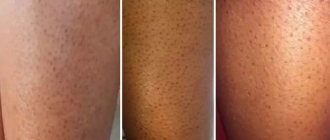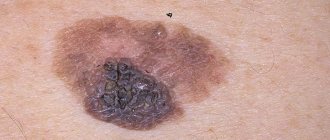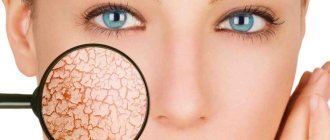Mole or medical term Nevus.
This is a collective name for limited, benign formations of the skin or mucous membranes.
The development of which is based on melanocytes - specialized skin cells that produce melanin.
Fair-skinned people have an average of 20 to 30 nevi.
Some are congenital or develop after birth in young children.
With age, the number of moles may increase, which is not considered a pathology.
Acquired moles are associated with the accumulation of pigment-forming cells.
Such as melanocytes in the upper layers of the skin.
If we consider in detail, the nevus is located either in the epidermis, in the dermis (corium), or at the border between these layers of skin.
Such spots can vary in color, being light, dark brown and even black.
Some moles are flat, others are raised.
Intense and constant exposure of the skin to ultraviolet light, as well as hormonal causes, cause or accelerate the development of birthmarks.
In principle, the development of moles is a complex process.
Biological factors and the environment play an important role.
Nevus is usually benign.
Therefore, the reasons for surgical removal are mainly cosmetic.
Only if the spot is perceived as alarming, for example, its color or shape has changed dramatically, is a detailed examination prescribed to determine subsequent treatment.
Black moles attract special attention.
They may appear against the background of hormonal changes during pregnancy and lactation.
Most patients consider the appearance of a dark nevus as an increased risk of developing skin cancer.
However, not every black mole on the skin is melanoma; however, they require consultation with a doctor.
First, the specialist will evaluate the clinical change in the formation by viewing it with the naked eye.
The next step in diagnosis will be dermatoscopy.
Dermatoscopy is a diagnostic procedure.
Used to differentiate skin lesions.
Allows you to determine whether a black mole is of epidermal, vascular or melanocytic origin.
Causes of moles
Most moles form in childhood and adolescence. Heredity and genetic predisposition play a key role. In adulthood, the appearance of new formations is facilitated by external and endogenous factors. The most important is hyperinsolation - regular and prolonged exposure of the skin to ultraviolet radiation.
Ultraviolet light is the main catalyst for the formation of melanin pigment in skin cells, and it is melanin that determines the color of the entire skin and its elements. The appearance of a black mole may be a consequence of too frequent and long exposure to the sun. Fans of artificial tanning are at risk, since solarium lamps are a source of intense ultraviolet radiation.
Changes in hormonal balance can contribute to the appearance of new nevi. For women, a risk factor is ovarian dysfunction (imbalance of sex hormones). Changes in hormonal levels can be triggered by taking oral contraceptives and hormone replacement therapy during menopause. The formation of black moles is possible during pregnancy and lactation.
Causes of dark inclusions
Moles are often found on the skin in places where they can be easily injured. Under the breasts or in the armpits of women, they are rubbed by underwires and bra straps. Men experience nevus damage on their necks due to tight ties and shirt collars. It is easy to disrupt the integrity of the formation in the head with a comb with sharp teeth. It is possible that the covers may be rubbed by rough seams on things. You can simply touch a mole with a fingernail, jewelry, or metal fittings on clothing. Usually, when a nevus is torn off, short-term pain occurs. Blood may be released, and after it clots, black spots remain on the mole. After injury, changes should be closely monitored.
Another cause of blackheads can be hormonal imbalance in the body. Most often they appear in girls during pregnancy, lactation, after abortion, and in women during menopause. In guys, disruptions in hormone levels are observed during puberty. In older people, the appearance of dark spots is associated with age-related changes in the body and is not dangerous. Also, do not panic if you find a black dot on a mole due to infection with papillomavirus. Although this phenomenon is not considered normal, it responds well to surgical treatment.
Dangerous symptoms
Only a very few black moles pose a potential threat. The risk of malignant transformation to melanoma is low, but caution should be maintained. In any case, it is advisable to show the skin lesion to a specialist. You definitely need to see a dermatologist or oncologist if you have the following symptoms:
- The black mole increases in size. Even small growth should be alarming; a rapid increase in size is an unfavorable sign.
- The surface has changed (becomes “glossy” or loose).
- The formation peels off or bleeds.
- Unpleasant sensations appear in the form of pain, burning or itching.
- The shape has changed, the edge has become striated, uneven, asymmetrical.
- The color changes: an ordinary mole becomes black, bluish or dark brown.
Any dynamics should be alarming. There is no need to panic, but you need to make an appointment with a specialist. What you definitely cannot do is try to remove the tumor yourself using traditional medicine. Injury by mechanical or chemical influence is one of the main causes of malignant degeneration.
Types of malignant tumors
Oncodermatologists have developed a classification of dark spots. It is divided into four types.
Superficial spreading melanoma affects the top layer of skin. A dark dot inside a mole with blurred edges slowly grows and gradually turns into a rough bump. Over time, it becomes shiny and dense with noticeable light inclusions inside the black spots. Upon contact with anything, the formation releases a yellowish liquid with blood, causing pain. Usually occurs in women after 35 years of age.
With nodular, the most dangerous, transformation from a benign to a malignant formation occurs in a short time. The nevus becomes dark - blue, black brown. Occasionally its shade turns out to be red or pink. Small black nodules appear on the surface in large numbers, and when touched, ichor is released.
Acral lentiginosis affects the nail plates on the hands and feet, destroying them. The soles, hands and mucous membranes are also affected. It is developing rapidly. Black spots appear on the neoplasms, often developing into ulcers. The disease primarily affects people with dark skin color, age does not matter.
Hutchinson's freckles most often occur in people over 60 years of age who are prone to increased pigmentation. Develop on the neck, face, back, arms. The nevus darkens over time and is slowly dotted with black spots, occasionally reaching a size of up to 10 centimeters. It often bleeds and hurts. The advantage is that the human immune system is able to detect skin defects and destroy them.
Not all dark spots are signs of incipient cancer, but you should not disregard such manifestations. Regular monitoring of them and timely visits to the doctor will save a person from problems.
Melanoma-dangerous nevi
Listed below are specific types of black moles that are melanoma-dangerous. This means that when exposed to unfavorable factors, they can degenerate into melanoma; the risk of malignant transformation is higher than in the case of ordinary nevi.
Dysplastic nevi. This type of nevi is characterized by the presence of melanocytic dysplasia, an atypical arrangement of melanocytes. Only a dermatologist can diagnose melanocyte dysplasia. The patient needs to know that a dysplastic nevus has a smooth surface. It does not rise above the skin, or only its central part rises. The shape is irregular, with uneven edges. The coloring is uneven, with black areas located in the center.
Blue nevus. Despite the name, the formation can be not only blue, but also black. Usually has the shape of a regular hemisphere and rises above the surface of the skin. The surface is smooth, the edges are even. Typical localization is the scalp, feet and hands, and gluteal region. The risk of malignancy increases after injury, including independent attempts at removal.
Nevus Ota. This type of tumor appears only on the face. Characteristic mainly for representatives of the Mongoloid race. The color is black or bluish. The differential sign is the presence of pigmentation of the sclera, iris or conjunctiva of the eye.
Borderline pigmented nevus. The neoplasm is formed in childhood. Subsequently, birthmarks increase in size throughout life, reaching one and a half to two centimeters in diameter. The differential feature is an uneven ring-shaped coloration, with a decrease in color intensity from the center to the periphery. The color is brown, darker in the central part.
Giant pigmented nevus. Refers to congenital. Increasing in size, such birthmarks reach gigantic sizes, up to 15 centimeters or more. A characteristic feature is an uneven surface with “potholes”, nodules and cracks. Hair growth from the nevus may occur.
For melanoma-dangerous moles, the risk of malignancy is higher than for ordinary skin tumors. Such nevi and birthmarks require observation by a dermatologist or oncologist. Malignant degeneration can be caused by exposure to external factors - mechanical or chemical damage, ultraviolet irradiation.
Why
Sometimes a situation arises when black dots appear on the nevus. The causes of the pathology are simple.
- Prolonged exposure to sunlight has a detrimental effect on human skin, especially for Caucasian people. Ultraviolet irradiation causes darkening of parts of the tumor due to the accumulation of melanin. This is a protective reaction of the body.
- Frequent visits to the solarium and prolonged sessions pose a danger. As a result, lovers of artificial tanning receive a loading dose of ultraviolet radiation. As a result, pathology occurs.
- Accidental injury to the nevus: cut, burn, blow, also causes darkening of individual areas. Most often this goes away without a trace, but there are cases when the formation degenerates into melanoma - a cancerous tumor that requires surgical intervention. In addition to damage, heredity also plays a role.
Diagnostics
If you have a black mole on your body, it is not at all necessary to remove it, but you need to contact a specialist. The dermatologist will conduct a diagnosis, which consists of examining the neoplasm and studying it using optical or digital dermatoscopy (under magnification).
During the examination, the doctor evaluates the size of the tumor, its density, structure, consistency, surface character, symmetry, edge, color and other signs. As a rule, examination and dermatoscopy are sufficient to make a diagnosis. Biopsy and histological examination are carried out only before removal. In other situations, dermatologists prefer not to injure black moles unnecessarily.
Is darkening of a nevus dangerous, and when should you see a doctor?
If a mole turns black, what does it mean, and could it be a dangerous sign? Unfortunately, this option cannot be ruled out. The risk of degeneration exists even with an ordinary mole, and if it was originally black, then this probability increases several times.
What signs should you look out for?
The fact that a small black mole has appeared is not enough to raise suspicions about it. To be concerned and seek help from a doctor, the growth must:
Treatment: removal or observation?
Benign neoplasms of the skin do not require removal, but surgery can be performed for aesthetic reasons, as well as in situations where the nevus is located in an open area of the body, is exposed to ultraviolet radiation, or is injured by parts of clothing or jewelry.
Removal of benign black moles that are not melanoma-dangerous is carried out in the following ways:
- Surgical removal;
- cryodestruction;
- electrocoagulation;
- radio wave removal;
- laser removal.
Melanoma-dangerous nevi can only be removed surgically. The operation is performed in the presence of an oncologist and involves healthy skin. The removed tissues are necessarily sent for histological examination. Melanoma-dangerous nevi can also be removed in aesthetic medicine clinics if the medical institution has a dermatologist oncologist on staff. The operation is performed in a classical way; cryodestruction and other modern technologies are not used.
If malignant degeneration of the neoplasm is diagnosed, complex antitumor therapy is indicated, which includes surgical removal with wide coverage of adjacent tissues, radiation and chemotherapy.
Prevention methods
The main cause of cancer is ultraviolet radiation. Black spots on a mole are areas with a high content of melanin. As you know, pigment is formed under the influence of sunlight, preventing the development of burns. But when cells can no longer protect against harmful radiation, they begin to mutate and acquire malignant properties. This is why you should protect your body and face from sunbathing. This rule is especially acute for people with fair skin, freckles and a large number of moles. It is undesirable to be on the street, and especially on the beach, in the summer from 12 to 3 o'clock in the afternoon. Favorable times for sunbathing are morning and evening. You should definitely use sunscreen.
It is also important to avoid injury to nevi, rubbing with clothing items, or scratching. Large lesions should be periodically shown to a dermatologist so that if cancer is suspected, tissue samples can be sent for analysis in a timely manner. Do not panic when you find a black dot on the surface of a nevus. In most cases, it is the result of an injury that goes away on its own. But several black dots combined with an uneven shade of the mole may indicate the development of one of the forms of melanoma.
After the procedure
After removing a nevus, it is extremely important to protect the skin from ultraviolet radiation. You can’t sunbathe in a solarium; you should be in the sun as little as possible. It is recommended to refrain from thermal procedures. It is impossible to remove crusts at the site of the surgical wound; the skin should be provided with maximum rest. After removing a mole on the face, it is not advisable to use decorative cosmetics.
You can learn more about the diagnosis of skin tumors and methods of their treatment at a consultation with a dermatologist at the Galaktika clinic (Moscow).
Treatment of melanoma moles
Melanoma, a type of skin cancer, can pose a serious threat not only to the health, but also to the life of the patient. That is why, when a cancerous mole is detected, it is subjected to immediate excision, while also removing the surrounding tissue at a distance of about 5 cm. Together with the epidermal integument (skin), all subcutaneous structures, including the fascia - the connective membrane, are subject to excision. If melanoma is diagnosed on a finger or toe, amputation may be considered.
Preventing the development of this oncological process is much easier than getting rid of skin cancer, and therefore, if you have any suspicions or doubts about the nature of the mole, you should immediately consult with an experienced specialist who will recommend one of the simple and safe methods of hardware removal of such a skin tumor.
Melanoma is one of the most dangerous cancer conditions in terms of metastasis. In this regard, only an experienced and qualified specialist will be able to provide prompt and rational assistance. Medical doctors have all the necessary knowledge and skills that allow them to defeat this terrible disease every day and save the lives of their patients. You can make an appointment today.
Find out the cost of the procedure “Removal of tumors”










